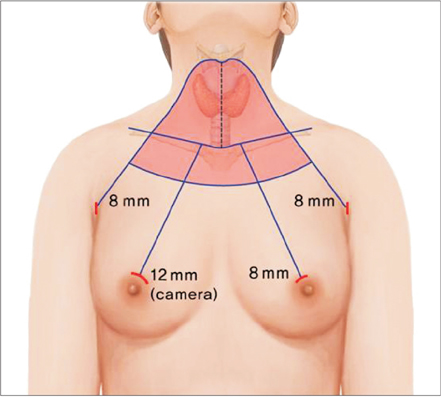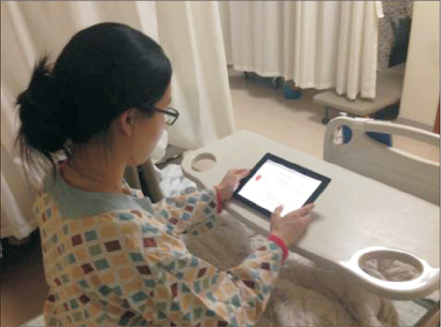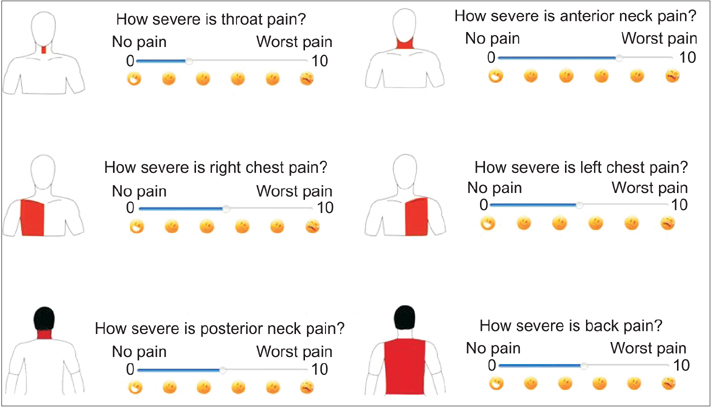Ann Surg Treat Res.
2016 May;90(5):239-245. 10.4174/astr.2016.90.5.239.
A comparative study of postoperative pain for open thyroidectomy versus bilateral axillo-breast approach robotic thyroidectomy using a self-reporting application for iPad
- Affiliations
-
- 1Department of Surgery, Seoul Metropolitan Government-Seoul National University Boramae Medical Center, Seoul, Korea.
- 2Cancer Research Institute, Seoul National University College of Medicine, Seoul, Korea. kyueunlee@snu.ac.kr
- 3Graduate School of Convergence Science and Technology, Seoul National University, Suwon, Korea.
- 4Department of Nursing, Seoul National University Hospital, Seoul National University College of Medicine, Seoul, Korea.
- 5Department of Surgery, Seoul National University Hospital, Seoul National University College of Medicine, Seoul, Korea.
- 6Department of Surgery, Seoul National University Bundang Hospital, Seongnam, Korea.
- KMID: 2163062
- DOI: http://doi.org/10.4174/astr.2016.90.5.239
Abstract
- PURPOSE
Postoperative pain for robotic thyroid surgeries including bilateral axillo-breast approach (BABA) has not been well studied. In this study, we have developed a self-reporting application (SRA) for iPad and prospectively collected pain scores from open thyroidectomy (OT) and BABA robotic thyroidectomy (RT) patients.
METHODS
Female patients who underwent total thyroidectomy for papillary thyroid carcinoma were included. Patients recorded pain scores for throat, anterior neck, posterior neck, chest, and back on postoperative days 1, 2, and 3. Once discharged, on postoperative day 14, a survey was also conducted on satisfaction of SRA and cosmesis.
RESULTS
A total of 54 patients were enrolled (27 BABA RT and 27 OT). There were no significant differences between the 2 groups in clinicopathological characteristics and postoperative complication rates. Postoperative pain scores at days 1, 2, 3, and 14 were not significantly different between the groups for throat, anterior neck, posterior neck, or back. Postoperative analgesic requirements were similar between the 2 groups. Wound satisfaction scores were significantly higher in the BABA RT group (BABA RT 7.4 vs. OT 5.7; P = 0.016). Satisfaction scores for the usefulness of SRA were above 7.2 for all four questionnaire items on the 10-point scale.
CONCLUSION
Postoperative pain for BABA RT is equivalent to OT but offers greater cosmetic satisfaction for patients. A mobile device application such as SRA may facilitate proper assessment and management of pain in postoperative patients.
MeSH Terms
Figure
Cited by 2 articles
-
Preliminary study on application of augmented reality visualization in robotic thyroid surgery
Dongheon Lee, Hyoun-Joong Kong, Donguk Kim, Jin Wook Yi, Young Jun Chai, Kyu Eun Lee, Hee Chan Kim
Ann Surg Treat Res. 2018;95(6):297-302. doi: 10.4174/astr.2018.95.6.297.Transoral endoscopic surgery for papillary thyroid carcinoma: initial experiences of a single surgeon in South Korea
Jin Wook Yi, Sang Gab Yoon, Hyun Soo Kim, Hyeong Won Yu, Su-Jin Kim, Young Jun Chai, June Young Choi, Kyu Eun Lee
Ann Surg Treat Res. 2018;95(2):73-79. doi: 10.4174/astr.2018.95.2.73.
Reference
-
1. Kim WW, Kim JS, Hur SM, Kim SH, Lee SK, Choi JH, et al. Is robotic surgery superior to endoscopic and open surgeries in thyroid cancer? World J Surg. 2011; 35:779–784.2. Kang SW, Jeong JJ, Yun JS, Sung TY, Lee SC, Lee YS, et al. Robot-assisted endoscopic surgery for thyroid cancer: experience with the first 100 patients. Surg Endosc. 2009; 23:2399–2406.3. Lee S, Lee CR, Lee SC, Park S, Kim HY, Son H, et al. Surgical completeness of robotic thyroidectomy: a prospective comparison with conventional open thyroidectomy in papillary thyroid carcinoma patients. Surg Endosc. 2014; 28:1068–1075.4. Lee KE, Choi JY, Youn YK. Bilateral axillobreast approach robotic thyroidectomy. Surg Laparosc Endosc Percutan Tech. 2011; 21:230–236.5. Kim HY, d'Ajello F, Woo SU, Son GS, Lee JB, Bae JW. Robotic thyroid surgery using bilateral axillo-breast approach: personal initial experience over two years. Minerva Chir. 2012; 67:39–48.6. Lee KE, Kim E, Koo do H, Choi JY, Kim KH, Youn YK. Robotic thyroidectomy by bilateral axillo-breast approach: review of 1,026 cases and surgical completeness. Surg Endosc. 2013; 27:2955–2962.7. Lee KE, Koo do H, Im HJ, Park SK, Choi JY, Paeng JC, et al. Surgical completeness of bilateral axillo-breast approach robotic thyroidectomy: comparison with conventional open thyroidectomy after propensity score matching. Surgery. 2011; 150:1266–1274.8. Lee KE, Koo do H, Kim SJ, Lee J, Park KS, Oh SK, et al. Outcomes of 109 patients with papillary thyroid carcinoma who underwent robotic total thyroidectomy with central node dissection via the bilateral axillo-breast approach. Surgery. 2010; 148:1207–1213.9. Breivik H, Stubhaug A. Management of acute postoperative pain: still a long way to go! Pain. 2008; 137:233–234.10. Stanford EA, Chambers CT, Craig KD. A normative analysis of the development of pain-related vocabulary in children. Pain. 2005; 114:278–284.11. Ryu HR, Lee J, Park JH, Kang SW, Jeong JJ, Hong JY, et al. A comparison of postoperative pain after conventional open thyroidectomy and transaxillary single-incision robotic thyroidectomy: a prospective study. Ann Surg Oncol. 2013; 20:2279–2284.12. Ban EJ, Yoo JY, Kim WW, Son HY, Park S, Lee SH, et al. Surgical complications after robotic thyroidectomy for thyroid carcinoma: a single center experience with 3,000 patients. Surg Endosc. 2014; 28:2555–2563.13. Lee J, Nah KY, Kim RM, Ahn YH, Soh EY, Chung WY. Differences in postoperative outcomes, function, and cosmesis: open versus robotic thyroidectomy. Surg Endosc. 2010; 24:3186–3194.14. Tae K, Ji YB, Cho SH, Lee SH, Kim DS, Kim TW. Early surgical outcomes of robotic thyroidectomy by a gasless unilateral axillo-breast or axillary approach for papillary thyroid carcinoma: 2 years' experience. Head Neck. 2012; 34:617–625.15. Årsand E, Froisland DH, Skrovseth SO, Chomutare T, Tatara N, Hartvigsen G, et al. Mobile health applications to assist patients with diabetes: lessons learned and design implications. J Diabetes Sci Technol. 2012; 6:1197–1206.16. Hallberg I, Taft C, Ranerup A, Bengtsson U, Hoffmann M, Hofer S, et al. Phases in development of an interactive mobile phone-based system to support self-management of hypertension. Integr Blood Press Control. 2014; 7:19–28.17. Turney BW, Reynard JM. Obtaining patient feedback in an outpatient lithotripsy service is facilitated by use of a touchscreen tablet (iPad™) survey. Urolithiasis. 2014; 42:317–321.
- Full Text Links
- Actions
-
Cited
- CITED
-
- Close
- Share
- Similar articles
-
- Bilateral axillo-breast approach robotic total thyroidectomy without isthmectomy: a case report
- Endoscopic Thyroidectomy via an Axillo-bilateral Breast Approach: 5 Years of Experience
- Analysis of Initial Experience of Robotic Bilateral Axillo-Breast Approach Thyroidectomy For 30 Months
- Evaluation of Surgical Completeness in Endoscopic Total Thyroidectomy with Central Neck Dissection via a Unilateral Axillo-Breast Approach Compared with Bilateral Axillo-Breast and Open Approach
- Transoral Robotic Thyroidectomy




